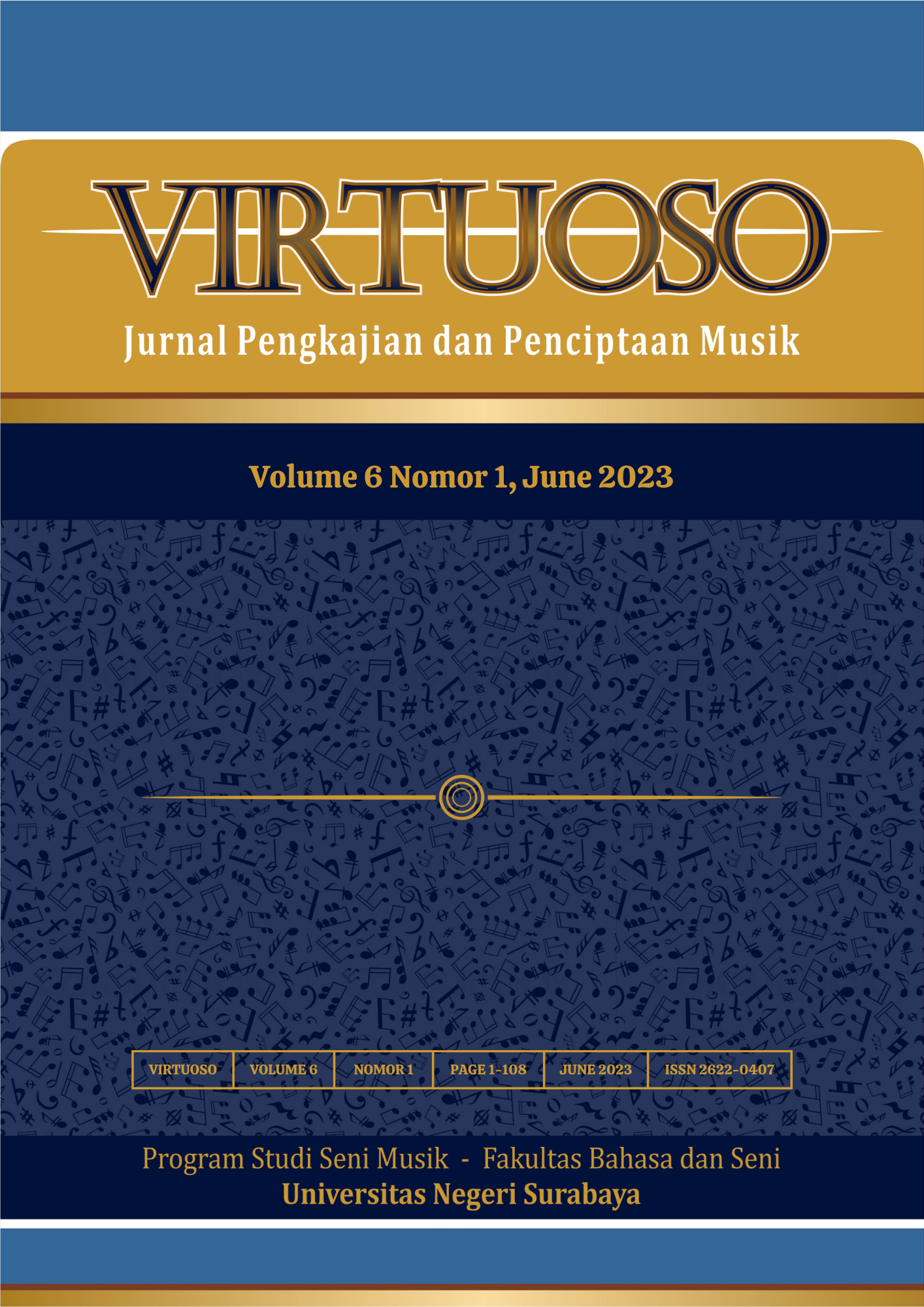Representation of Lian Namang Music In The Besi Pare Ritual With An Ecofeminist Approach
Main Article Content
Abstract
Music is a universal language that can penetrate space and time. However, traditional music requires semi-improvisation to adjust to environmental conditions. Lian Namang's music for the Lamaholot community is a traditional music that tells some of the life philosophies of the predecessor community. One type of Lian Namang music is used in the Lamaholot tradition to personify a feminine figure in the mythology of the goddess of rice. Lian Namang's musical lyrics in rice mythology require contextuality with the times. In connection with the phenomenology that occurs in the Lamaholot culture, that patriarchal culture becomes dominant in the domination of nature and women, it is necessary to hold contextual musical representations based on Lian Namang's music so that they can have a persuasive influence on the Lamaholot community in respecting women and nature as the womb of life. The results of the research are used as a medium to represent the ecofeminist movement, which aims to influence society in responding to patriarchal culture. Masculine representation is not only seen as a centre (androcentric) that dominates and uses a fragmented nature. The mukti trilila theory is one of the foundations that helps humans to continue to adapt their knowledge and skills to the times, so that the noble values of life are passed down from generation to generation.
Downloads
Article Details

This work is licensed under a Creative Commons Attribution-NonCommercial-ShareAlike 4.0 International License.
The copyright of the received article once accepted for publication shall be assigned to the journal as the publisher of the journal. The intended copyright includes the right to publish the article in various forms (including reprints). The journal maintains the publishing rights to the published articles.
References
Arivia, G. (2006). Feminisme: Sebuah Kata Hati. Jakarta: Penerbit Kompas.
Berry T. Kosmologi Kristen, Penerj., : Amelia Hendani, Maumere: Ledalero, 2013.
Kleden, M. Hak Asasi Manusia Dalam Masyarakat Komunal. Kajian Atas Konsep HAM Dalam Teks-Teks Adat Lamaholot Dan Relevansinya Terhadap HAM Dalam UUD 1945. Yogyakarta : Penerbit Lamalera, 2008.
Muda, Y. Ata Lamaholot Dalam Sorotan Budaya. Yogyakarta : Penerbit Kanisius, 2016
Pampus. K. H. Mue Moten Koda Kiwan. Mue Moten Koda Kiwan. Kamus Bahasa Lamaholot. Frankfurt: Frobenius-Institut Frankfurt Am Main, 2001.
Rappoport, Dana. (2011). To sing the rice in Tanjung Bunga (eastern Flores, Indonesia), in: B. Abels (ed.), Austronesian soundscapes; Performing arts in Oceania and Southeast Asia, pp. 103-131. Amsterdam: Amsterdam. University Press.
Rappoport, Dana. (2014). Songs and sorrow in Tanjung Bunga; Music and the myth of the origin of rice (Lamaholot, Flores, Indonesia), Bijdragen tot de Taal-, Land- en Volkenkunde 170 (2-3): 215-249.
Sarwono, J. dan Hary Lubis, Metode riset untuk Desain komunikasi visual, Jogjakarta: C.V Andi Offset, 2007.
Sedana, I Nyoman, dkk., (2021). Teori dan Metode Kreativitas Seni Berbasis Tradisi Kreatif Sanggit / Kawi Dalang. Denpasar: Dibiayai oleh Dana Dipa ISI Denpasar No. Dipa 023.17.2.677544/2021 tanggal 7 Februari 2021
Sedana, I Nyoman, dkk., Laporan PDUPT ISI Denpasar 2021
Tong, Rosemary Putnam. (2006). Feminist Thought: A More Comprehensive Introduction. Diterjemahkan dalam Bahasa Indonesia oleh Aquaini Priyatna Prabasmara. Bandung: JalasutraTangah Community. Seventh International Conference on Languages and Arts (ICLA 2018). Atlantis Press.
Trofimov, A., Sapsuyev, A., & Voitkevich, S. (2018). The Problem of the Origin and Development of Spiritual Verse as a Genre. 4th International Conference on Arts, Design and Contemporary Education. Atlantis Press. tasks. The Elementary School Journal, 100(3), 183-212. doi: 10.2307/1002151.

